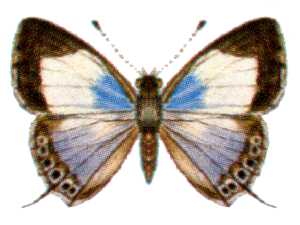Jameela
| Jameela | ||||||||||||
|---|---|---|---|---|---|---|---|---|---|---|---|---|

Illustration by Jameela palmyra |
||||||||||||
| Systematics | ||||||||||||
|
||||||||||||
| Scientific name | ||||||||||||
| Jameela | ||||||||||||
| Grund & Eastwood , 2010 |
Jameela is a genus of the family of Bläulinge . It was based on two species that were separated from the genus Erysichton because of molecular genetic and morphological differences. The way of life of the caterpillars also differs significantly and confirms the separation. Jameela palmyra feeds on parasitic belt flowers (Loranthaceae), whereas Erysichton lineata feeds on large-leaved rainforest trees from the families of the predatory plants (Boraginaceae), myrtle plants (Myrtaceae), silver tree plants (Proteaindceae) and sapidaceae . The name Jameela is derived from the anglicised translation for the Arabic word "beautiful".
features
The genus differs from the genus Erysichton among other things by the pattern of the wing undersides; the strongly spotted terms (wing edges distal from the body) of the wing tops, which are missing in Erysichton ; the wing vein CuA 1 of the forewings, which is less curved in Jameela ; the tornus of the male forewings, which is angular in Jameela , whereas in Erysichton it is more rounded, and the tails on the tornus of the hind wings, which are at least partially developed in Jameela . In contrast to Erysichton , which has elongated paddle-like scent scales , these are shaped like a shuttlecock in the Jameela genus . These scales are so dense on both the fore and the hind wing tops that they cause the silky purple color in the males.
In the male, the genitals are clearly compressed in their longitudinal axis and are only about three-quarters the length of those of the genus Erysichton . In Jameela the vinculum is almost straight when viewed from the side, in Erysichton it is strongly curved. It is also very narrow at Jameela and less than half as wide as that at Erysichton . The blades are half as long as those at Erysichton and have only one appendix instead of two. The sinus is much wider and the socii are less powerful compared to Erysichton . In addition, the cecum in Erysichton is not bulbous, the ductus seminalis in Erysichton clearly enters the aedeagus on the left dorsal side and the juxta is stronger, strongly curved and the T-shaped prongs are very flat. The seminal duct in the females of Jameela palmyra is only weakly curled. The compound eyes also differ between the genera. In Jameela the REP (reflective eye pattern) is pigmented white (Type III), whereas in Erysichton it is black and unpigmented (Type I).
Occurrence and way of life
The genus is mainly native to and around Australia and occurs from Maluku in the west, east to Papua New Guinea , the Bismarck Archipelago , the Solomon Islands and the coasts of eastern Australia. It colonizes tropical and subtropical rainforests and other forest habitats. The representatives of the genus appear sympatric with Erysichton lineata .
The caterpillars of Jameela palmyra have been detected on belt flowers (Loranthaceae). It is only known that they are fully grown reddish-brown and resemble those of Erysichton lineata , but differ from these by a smoother surface of their horizontally flattened (onisciform) body. The pupae of the species, like the eggs, are unknown; of Jameela albiplaga all pre-imaginal stages as well as the food plants are unknown.
Taxonomy and systematics
The genus was established on the basis of an investigation by Grund & Eastwood in 2010 from two species that were separated from the genus Erysichton . The latter genus now includes only the type species Erysichton lineata and thus became monotypical . A molecular genetic study of Jameela albiplaga could not be carried out. The species was assigned to the genus Jameela on the basis of the statement by Tite (1963) that the male genitalia are morphologically identical to those of J. palmyra and further morphological matches, which were made on the basis of high-resolution photos of the holotype and allotype .
The following species are assigned to the genus:
- Jameela palmyra ( C. Felder , 1860)
- Jameela albiplaga ( Tite , 1963)
supporting documents
Individual evidence
- ↑ a b c d e f Roger Grund & Rod Eastwood: New Australian butterfly genus Jameela gen. Nov. (Lepidoptera: Lycaenidae: Polyommatinae: Polyommatini) revealed by morphological, ecological and molecular data . In: Entomological Science . No. 13, 2010, pp. 134-143. doi : 10.1111 / j.1479-8298.2010.00368.x .